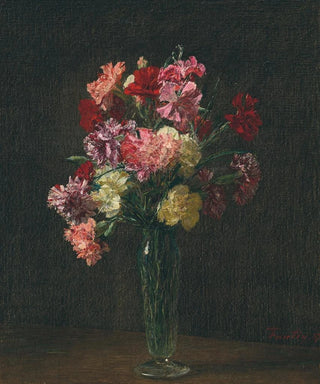Art print | Carnations - Henri Fantin-Latour


View from behind

Frame (optional)
Reproduction of Carnations - Henri Fantin-Latour – Captivating Introduction
In the art world, some works transcend time and touch the soul through their beauty and delicacy. "Carnations" by Henri Fantin-Latour is one of those creations that captivate the eye and evoke deep emotions. This painting, which evokes the fragility and brilliance of nature, is much more than a simple floral representation. It embodies a dialogue between the artist and his subject, where each petal seems to whisper secrets of beauty and life. The light that caresses the flowers, the delicate nuances of the colors, all contribute to creating an atmosphere of serenity and contemplation. By contemplating this work, the viewer is transported into a universe where nature rises to the rank of art, inviting reflection on the ephemeral beauty of life.
Style and uniqueness of the work
Henri Fantin-Latour, master of realism and still life, manages to capture the very essence of flowers with remarkable precision. In "Carnations," every detail is carefully crafted, from the contours of the petals to the light shadows that give depth to the composition. The choice of colors, both vivid and nuanced, creates a visual harmony that delights the eye. Fantin-Latour excels in the art of light, using plays of shadow and clarity to bring his subjects to life. This work is a perfect example of his unique style, which combines realism and poetry. The carnations, symbols of love and passion, are presented here with such delicacy that they seem to vibrate almost under the viewer's gaze. The artist succeeds in conveying a deep emotion through the apparent simplicity of his composition, making this work a true masterpiece.
The artist and his influence
Henri Fantin-Latour, born in 1836 in Grenoble, is an emblematic figure of the French artistic movement of the 19th century. His prolific career is marked by a passion for nature and admiration for the great masters of painting. Influenced by artists such as Courbet and Manet, Fantin-Latour develops a style that combines technical precision and poetic sensitivity.

Matte finish

View from behind

Frame (optional)
Reproduction of Carnations - Henri Fantin-Latour – Captivating Introduction
In the art world, some works transcend time and touch the soul through their beauty and delicacy. "Carnations" by Henri Fantin-Latour is one of those creations that captivate the eye and evoke deep emotions. This painting, which evokes the fragility and brilliance of nature, is much more than a simple floral representation. It embodies a dialogue between the artist and his subject, where each petal seems to whisper secrets of beauty and life. The light that caresses the flowers, the delicate nuances of the colors, all contribute to creating an atmosphere of serenity and contemplation. By contemplating this work, the viewer is transported into a universe where nature rises to the rank of art, inviting reflection on the ephemeral beauty of life.
Style and uniqueness of the work
Henri Fantin-Latour, master of realism and still life, manages to capture the very essence of flowers with remarkable precision. In "Carnations," every detail is carefully crafted, from the contours of the petals to the light shadows that give depth to the composition. The choice of colors, both vivid and nuanced, creates a visual harmony that delights the eye. Fantin-Latour excels in the art of light, using plays of shadow and clarity to bring his subjects to life. This work is a perfect example of his unique style, which combines realism and poetry. The carnations, symbols of love and passion, are presented here with such delicacy that they seem to vibrate almost under the viewer's gaze. The artist succeeds in conveying a deep emotion through the apparent simplicity of his composition, making this work a true masterpiece.
The artist and his influence
Henri Fantin-Latour, born in 1836 in Grenoble, is an emblematic figure of the French artistic movement of the 19th century. His prolific career is marked by a passion for nature and admiration for the great masters of painting. Influenced by artists such as Courbet and Manet, Fantin-Latour develops a style that combines technical precision and poetic sensitivity.






